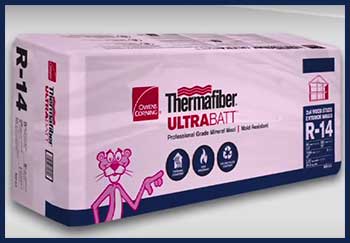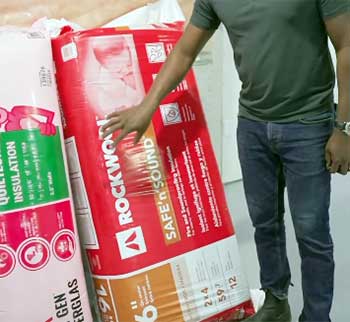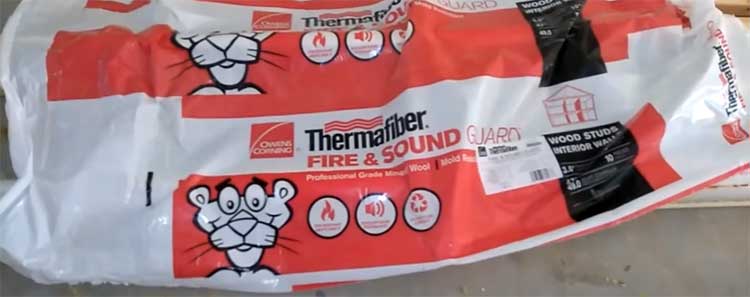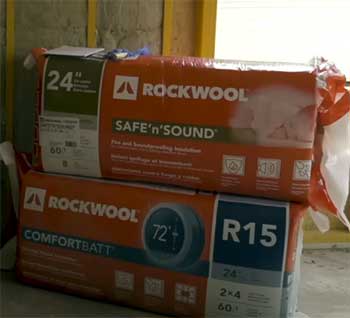I’ve spent years researching and working with insulation materials, and few debates spark as much interest as Thermafiber versus Rockwool. Both are heavyweights in the mineral wool insulation world, promising energy efficiency, fire resistance, and soundproofing.
But which one truly fits your needs?
In this article, I’ll break down their features, weigh their pros and cons, and share my insights to help you decide. Whether you’re insulating a home, office, or studio, I’ll guide you through the nuances of these materials to ensure you make an informed choice.
A Brief Comparison Table
| Feature | Thermafiber | Rockwool |
| Material Composition | Primarily slag (70%+ recycled content) with some rock | Mostly basalt rock (98%) with slag and coke |
| R-Value (per inch) | 3.0–4.2 | 3.0–3.3 |
| Fire Resistance | Non-combustible, withstands 2,000°F+ | Non-combustible, withstands 2,000°F+ |
| Sound Absorption (NRC) | 0.95–1.10 (excellent) | 0.80–0.95 (very good) |
| Water Resistance | 0.03% absorption rate | 0.1% absorption rate |
| Cost (per sq. ft.) | $0.70–$1.50 | $1.50–$2.00 |
| Installation Ease | Flexible, easier for tight corners | Rigid, better for flat surfaces |
| Environmental Impact | 70–75% recycled content, LEED-certified | 16–40% recycled content, GREENGUARD-certified |
| Applications | Walls, floors, ceilings (wood/steel) | Walls, ceilings, green roofing, industrial |
| Health/Safety | Dusty, requires protective gear | Slightly less dusty, requires protective gear |
What Are Thermafiber And Rockwool?

When I first started exploring insulation options, I was struck by how similar yet distinct Thermafiber and Rockwool are.
Both fall under the mineral wool umbrella, a category of insulation made from molten rock or industrial byproducts spun into fibrous batts or boards.
Thermafiber, produced by Owens Corning, leans heavily on slag—a byproduct of steel production—mixed with some natural rock.
Rockwool, on the other hand, is primarily basalt rock, a volcanic material, combined with slag and coke. These differences in composition set the stage for their unique strengths.
Thermafiber’s slag-heavy makeup gives it a high recycled content, often exceeding 70%. Rockwool, with its basalt focus, boasts a near-pure rock composition (up to 98%).
Both are non-combustible, eco-friendly, and excellent at trapping heat and sound, but their performance varies slightly depending on the application. I’ve used both in projects, from home renovations to commercial builds, and each has moments where it shines.
Thermal Insulation: Keeping The Heat Where It Belongs
Let’s talk about keeping your space cozy. Thermal insulation is all about reducing heat transfer, which saves energy and keeps your bills in check. Both Thermafiber and Rockwool excel here, but there are nuances worth noting.
Thermafiber’s R-value, a measure of thermal resistance, ranges from 3.0 to 4.2 per inch, depending on the product (like UltraBatt or FireSpan). I’ve found it performs exceptionally well in walls and ceilings, especially in colder climates where heat retention is critical.
Its dense, fibrous structure traps air effectively, slowing heat flow. In one project, I insulated a drafty attic with Thermafiber UltraBatt, and the homeowner reported a noticeable drop in heating costs.
Rockwool, with an R-value of 3.0 to 3.3 per inch, is no slouch either. Its ComfortBatt line is a go-to for residential walls, offering solid thermal performance. However, its slightly lower R-value range means it might not match Thermafiber’s efficiency in extreme conditions.
That said, Rockwool’s consistency across large, flat surfaces makes it a favorite for industrial or green roofing projects. I once worked on a commercial building where Rockwool’s rigid batts kept the interior comfortable despite scorching summer heat.
Pros of Thermafiber For Thermal Insulation:
- Higher R-value range for better heat retention in cold climates.
- Flexible batts fit snugly in irregular spaces, reducing thermal bridging.
- Certified by LEED for energy efficiency.
Cons of Thermafiber:
- Can be dustier during installation, which might affect air quality temporarily.
- Slightly more expensive for high-R-value products.
Pros of Rockwool for Thermal Insulation:
- Reliable performance across large, flat areas like roofs or walls.
- Maintains R-value over time, even in humid conditions.
- GREENGUARD-certified for low emissions.
Cons of Rockwool:
- Lower R-value per inch compared to Thermafiber’s top-end products.
- Rigid batts can be trickier to fit in tight or irregular spaces.
Fire Resistance: Safety First

Fire safety is a big deal, and both Thermafiber and Rockwool are champs in this arena.
As someone who’s seen the aftermath of a house fire, I can’t stress enough how crucial non-combustible insulation is.
Both materials withstand temperatures over 2,000°F without melting or catching fire, making them ideal for fire-prone areas or spaces near fireplaces.
Thermafiber’s high slag content gives it a slight edge in fire resistance. Its FireSpan products are often used in commercial buildings to create fire-rated assemblies, like one-hour fire walls. I recall a project where we used Thermafiber in a multi-family building, and it passed fire inspections with flying colors.
Rockwool is equally impressive, with its basalt-heavy composition providing excellent fire protection. It’s often used in industrial settings or exterior walls in wildfire-prone regions. During a renovation, I saw Rockwool Safe ‘n Sound hold up in a fire test, giving occupants precious extra minutes to evacuate.
Pros of Thermafiber for Fire Resistance:
- Exceptional performance in fire-rated assemblies.
- No added flame retardants, reducing chemical concerns.
- Widely used in commercial fireproofing.
Cons of Thermafiber:
- Dust from slag can irritate during installation, requiring masks.
Pros of Rockwool for Fire Resistance:
- Naturally fire-resistant due to basalt rock.
- Ideal for high-risk areas like attics or basements.
- No combustible additives.
Cons of Rockwool:
- Slightly higher cost for fire-specific products like Safe ‘n Sound.
Sound Absorption: Quieting the Noise

If you’ve ever lived next to a noisy neighbor, you know why soundproofing matters. Both Thermafiber and Rockwool are stellar at reducing noise, but their performance differs slightly.
Thermafiber’s noise reduction coefficient (NRC) ranges from 0.95 to 1.10, meaning it absorbs nearly all sound waves that hit it. I installed Thermafiber Fire and Sound Guard Plus in a home studio, and the client was thrilled with how it muffled external noise. Its dense, fibrous structure is particularly effective at blocking low-frequency sounds, like bass or traffic rumble.
Rockwool, with an NRC of 0.80 to 0.95, is still excellent but slightly less effective at lower frequencies. Its Safe ‘n Sound product is a favorite for home theaters and shared walls. I used it in a duplex, and the tenants reported a significant drop in noise bleed between units.
Pros of Thermafiber for Sound Absorption:
- Superior NRC for better low-frequency sound blocking.
- Ideal for studios, theaters, or noisy urban homes.
- Flexible batts conform to walls for tighter sound seals.
Cons of Thermafiber:
- Dustier installation can be a hassle in confined spaces.
Pros of Rockwool for Sound Absorption:
- Very good sound absorption, especially for mid-to-high frequencies.
- Rigid batts ensure consistent coverage on flat surfaces.
- Widely available in sound-specific products.
Cons of Rockwool:
- Slightly lower NRC than Thermafiber, less effective for bass-heavy noise.
Water and Mold Resistance: Staying Dry and Healthy

Moisture is the enemy of insulation, leading to mold and reduced effectiveness.
Both Thermafiber and Rockwool are designed to resist water, but their performance varies.
Thermafiber has a water absorption rate of just 0.03%, making it highly water-repellent.
Its inorganic materials resist mold growth, even in damp basements.
I once used Thermafiber in a flood-prone area, and it held up beautifully after a minor water incident, drying out without damage.
Rockwool’s water absorption rate is 0.1%, still excellent but slightly less resistant than Thermafiber. Its basalt-based structure also prevents mold, and it dries quickly if wetted. I’ve seen Rockwool used in green roofing, where its ability to handle occasional moisture is a big plus.
Pros of Thermafiber for Water Resistance:
- Extremely low water absorption (0.03%).
- Mold-resistant, ideal for humid climates.
- Maintains integrity even after wetting.
Cons of Thermafiber:
- Installation dust can be a concern in poorly ventilated areas.
Pros of Rockwool for Water Resistance:
- Solid water resistance (0.1% absorption).
- Mold-resistant and durable in damp conditions.
- Suitable for exterior or roofing applications.
Cons of Rockwool:
- Slightly higher water absorption than Thermafiber.
Installation: Getting It Done Right
Installing insulation isn’t exactly glamorous, but ease of use matters. I’ve wrestled with both materials, and each has its quirks.
Thermafiber’s batts are more flexible, making them easier to fit into tight corners or around pipes. I found this helpful in a retrofit project where walls were far from perfect. You can cut Thermafiber with a utility knife, and it compresses nicely to fill gaps. However, it’s dustier, so I always wear a mask and gloves.
Rockwool is denser and more rigid, which is great for flat surfaces but less forgiving in irregular spaces. Its batts don’t require stapling, as they friction-fit snugly. I used Rockwool ComfortBatt in a new build, and it went in smoothly, but cutting it required a serrated knife for precision.
Pros of Thermafiber for Installation:
- Flexible batts for irregular spaces.
- Easy to cut and shape.
- Fits wood and steel framing.
Cons of Thermafiber:
- Dustier, requiring more protective gear.
- Can be harder to source in some regions.
Pros of Rockwool for Installation:
- Rigid batts for quick installation on flat surfaces.
- Friction-fit reduces need for fasteners.
- Less dusty than Thermafiber.
Cons of Rockwool:
- Harder to cut precisely for tight spaces.
- More expensive for large projects.
Environmental Impact: Going Green
As someone who cares about sustainability, I appreciate that both Thermafiber and Rockwool prioritize eco-friendly practices. Thermafiber uses 70–75% recycled content, primarily slag, and is LEED-certified.
Its production process reduces greenhouse gas emissions, and the material itself is recyclable. I’ve seen Thermafiber used in green building projects, earning points for sustainability.
Rockwool uses 16–40% recycled content, depending on the product, and is GREENGUARD-certified for low emissions. Its basalt-heavy composition relies on abundant natural resources, but its carbon footprint is slightly higher due to energy-intensive manufacturing.
I’ve used Rockwool in projects aiming for environmental certifications, and it performs well.
Pros of Thermafiber for Environmental Impact:
- High recycled content (70–75%).
- LEED-certified, supporting green building goals.
- Recyclable at end of life.
Cons of Thermafiber:
- Slag-based production still requires energy.
Pros of Rockwool for Environmental Impact:
- Uses abundant basalt rock.
- GREENGUARD-certified for indoor air quality.
- Recyclable with low chemical emissions.
Cons of Rockwool:
- Lower recycled content than Thermafiber.
- Higher energy use in manufacturing.
Cost and Value: What’s Your Budget?
Cost is often the deciding factor, and I’ve learned that balancing upfront expenses with long-term savings is key.
Thermafiber typically costs $0.70–$1.50 per square foot, depending on the product and region. Its lower cost and high performance make it a budget-friendly choice for many projects. I used Thermafiber UltraBatt in a rental property, and the savings on energy bills made it worth every penny.
Rockwool is pricier, ranging from $1.50 to $2.00 per square foot. Its durability and performance justify the cost for long-term investments, especially in commercial or high-risk areas.
I installed Rockwool in a client’s home theater, and they appreciated the soundproofing enough to overlook the higher price tag.
Pros of Thermafiber for Cost:
- More affordable than Rockwool.
- Offers excellent value for thermal and sound performance.
- Widely used in budget-conscious projects.
Cons of Thermafiber:
- May require more material for high R-value needs.
Pros of Rockwool for Cost:
- Long-term durability reduces replacement costs.
- Premium performance for specialized applications.
- Widely available in bulk.
Cons of Rockwool:
- Higher upfront cost.
- Less cost-effective for large-scale projects.
Applications: Where Each Shines
Thermafiber and Rockwool are versatile, but their strengths suit different scenarios. Thermafiber’s flexibility makes it ideal for residential walls, floors, and ceilings, especially in wood or steel-framed buildings.
I’ve used it in attics, basements, and even sound studios, where its sound absorption is a game-changer.
Rockwool excels in industrial settings, green roofing, and exterior walls. Its rigidity is perfect for large, flat surfaces, and its moisture resistance makes it a top choice for basements or outdoor applications.
I’ve seen Rockwool transform a noisy office into a quiet workspace with minimal effort.
Pros of Thermafiber for Applications:
- Versatile for residential and commercial use.
- Excellent for sound-sensitive spaces like studios.
- Fits irregular spaces easily.
Cons of Thermafiber:
- Less suited for large, flat industrial surfaces.
Pros of Rockwool for Applications:
- Ideal for industrial and roofing projects.
- Great for exterior walls and basements.
- Rigid structure ensures consistent coverage.
Cons of Rockwool:
- Less flexible for tight or irregular spaces.
Health and Safety: What You Need to Know
Handling insulation isn’t risk-free, and I’ve learned to take precautions. Both Thermafiber and Rockwool release dust and fibers during installation, which can irritate skin, eyes, and lungs.
Thermafiber is dustier due to its slag content, and I’ve coughed my way through installations without a mask. Rockwool is slightly less dusty, but protective gear is still a must.
Both materials are inorganic and don’t release harmful chemicals once installed. However, I always ventilate the area and wear gloves, goggles, and a respirator to stay safe.
Pros of Thermafiber for Health/Safety:
- No added flame retardants or chemicals.
- Mold-resistant, safe for indoor use.
Cons of Thermafiber:
- Dustier, requiring strict safety measures.
Pros of Rockwool for Health/Safety:
- Low chemical emissions, GREENGUARD-certified.
- Mold-resistant and safe post-installation.
Cons of Rockwool:
- Still requires protective gear during installation.
Frequently Asked Questions (FAQ)
Yes, Thermafiber is worth it for its affordability, high R-value, and excellent soundproofing, especially in residential projects or sound-sensitive spaces.
Rockwool is pricier, less flexible for tight spaces, and has a slightly higher water absorption rate (0.1%) compared to Thermafiber.
Rockwool outperforms fiberglass in fire resistance, soundproofing, and mold resistance, but fiberglass is cheaper and easier to install.
Sheep’s wool is a safer, eco-friendly alternative with low dust and no chemical emissions, though it’s slightly more expensive.
Conclusion: Making Your Choice
You’ve got a big decision ahead, and I hope this breakdown has clarified the strengths of Thermafiber and Rockwool. If budget and flexibility are your priorities, Thermafiber’s affordability and soundproofing make it a fantastic choice.
If you’re after durability and performance in industrial or exterior applications, Rockwool’s rigidity and fire resistance are hard to beat. Consider your project’s needs—thermal efficiency, noise control, or fire safety—and weigh the costs.
Whatever you choose, both materials will keep your space comfortable, safe, and energy-efficient. Let me know if you need more guidance!
